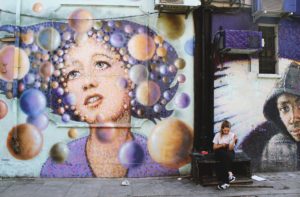
I was listening to a rebroadcast of a 1948 radio show. It was still quite funny. But I was bothered by the old commercials that were included from the original show. Here’s basically what they said.
Ladies! Why have dingy skin when you can have beautiful skin by washing your face with Palmolive Soap?…..AND….Why would ANY woman want dull, lifeless hair when she can have soft, touchable hair by using Lustre-Crème Shampoo?
It dawned on me that for nearly 70 years, beauty product marketing had targeted women with one primary and absolutely clear message: You are not OK the way you are.
One study showed that US advertisers spent 3.6 Billion dollars in 2013 trying to sell us cosmetics and beauty items, primarily focusing on women. And American consumers bought over 33 billion of products, so it was quite a return on investment. Of that 33 billion, men forked over just 1.5 billion.
So women are barraged by messages that they are not OK the way they are, BUT buying this product will fix you. Maybe.
With the multitude of flawless-faced models each selling a specific item, it’s hard NOT to be seduced into thinking, “I could be prettier if I use that product.” We forget that professionals have applied the make-up and done the hair, using many more products than the one being sold.
And that’s just what the beauty industry is counting on.
The Power of Habit by Charles Duhigg relates the story of ad exec Claude Hopkins who made a pile of money in the 1950s by convincing people to buy Pepsodent toothpaste.
Before that time, brushing our teeth was not a habit many Americans held, so it was difficult to sell toothpaste. Hopkins created a strategy that is still used in advertising today: a CUE leads to a CRAVING. When we act on the craving, we are REWARDED.
In reviewing stacks of dental research, Hopkins came across the term “mucin plaques” which is the ordinary light membrane that builds over our teeth. Everyone has it. You can temporarily get rid of it by swishing water, eating an apple, rubbing your (hopefully clean) finger across your teeth, or by brushing, no toothpaste required.
He renamed this ordinary substance “film” One of the first ads asked, “Why would any woman have dingy film on her teeth?” Well, duh. She is not OK the way she is.
After just three weeks of advertising, demand surpassed supply; there wasn’t enough Pepsodent to go around. It remained the best-selling toothpaste for 30 years. Here’s how it worked:
CUE: Run your tongue over your teeth. Feel that film? Yuck!
CRAVING: I want to have beautiful, film-free teeth. I’ll buy Pepsodent!
REWARD: My teeth feel so clean that I just know I’m more attractive!
And of course we don’t want to feel better just once. So that sets up the routine, the habit, of reaching for the product again and again.
The good news is that this advertising improved America’s overall dental hygiene. But that wasn’t the intention. The real lesson we learned is that toothpaste is a beauty enhancer.
It’s hard to say “no” to the enticing benefits the products promise they’ll deliver. And yes, most of us want to look as good as we can, myself included. But I’d like us to take a step back and consider what defines a truly beautiful person.
Because a truly beautiful person isn’t limited to a gender, a race, an age, a body shape or size NOR defined by talent, intelligence, or net worth. My ideal of a truly beautiful person is one who is joyful, authentic, empathic, mindful, forgiving, and grateful.
CUE: We’re tired of an industry telling us we’re not OK.
CRAVING: We want to be truly beautiful people.
REWARD: Our lives are filled with blessings beyond imagination because we receive back what we extend to others.
Let’s make being truly beautiful people our new habit.
To my readers: So what’s YOUR definition of truly beautiful?




“Truly Beautiful” is having friends who take you out for a birthday luncheon, bake you your favorite cake, and present you with hand-made gifts and a piece of beautiful jewelry from their own personal collection – just because……………..
Send them each this post so they know they’ve been publicly appreciated!
Truly beautiful is also seen in a person who really “listens” when you are having a conversation. I’m not talking about someone with a gifted memory, but about someone who understands the feelings you are expressing when having a conversation. That’s a real jewel of a friend who can listen without judgement, and not try to tell you what you SHOULD do. With a good listener, people feel a genuine sense of having been “heard” and then often move on with confidence to solve whatever situation had been troubling them.
Empathic listening is quite a gift. And I agree…if we just take the time to listen without imposing our view on how to fix things, the person will often come up with the best decision for himself or herself.